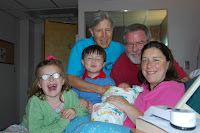No Certain Claim
(villanelle, poem for July 31, 2007)
The restless waiting holds me like a spell.
My daughter’s son will take my father’s name.
Which door will open? None of us can tell.
The summer’s long demise, its ghostly knell
sounds out, and nothing stays the same.
The eager waiting holds me like a spell.
Some days I pass like heaven’s infidel,
a lonely wanderer, no certain claim.
Which door will open? None of us can tell.
I hear my mother’s voice, clear as a bell,
call out to me, her world a shrinking frame.
The awful waiting holds me like a spell.
Grandchild and parent, each within a cell,
will find the key to this confining game.
Which door will open? None of us can tell.
These lonely vigils: who can stand them well?
I keep my peace and feed the earthly flame.
The endless waiting holds me like a spell
Which door will open? None of us can tell.
I've written a poem a day since July 1. This perhaps crazy and compulsive mass production started as a mutual challenge with my colleague Beckie Flannagan to write a daily poem, start to finish, for a month. Now, we're well into August, and the poems keep coming. Naturally, some of them are pretty bad, while others show some promise. No doubt some will remain buried in the depths of my poetry drawer. Others, though, I will certainly revise and send out. Among the 34 poems produced to date are three sonnets (July 13 and 20, August 2), a sestina (July 28), and a villanelle (July 31).
I'm not sure how long this will continue. At some point, certainly once I get into the thick of fall semester, I'm sure I'll want to spend more time evaluating and revising what I've done. Still, the past month's work reinforces what I've long known about the habit of writing and the importance of regular, if not daily, word work. William Stafford started each day with poetry writing, and many others have done the same. It's difficult to write strong, publishable poems, but it's not hard to write daily, especially once you've designated a time and place to do so. It's a lesson I try to teach all my students. The often-quoted Latin phrase for this is "nulla dies sine linea" (never a day without lines).
Ilija Melentijević, a Serbian who maintains
a blog called "Nulla dies sine linea", applies this slogan to his art: "Never a day without a drawing." The writer and writing teacher Don Murray wrote and sketched daily (see my blog entry on Murray for 4 January 2007).
See the
flickr page that attributes this dictum to Pliny, the Elder.
~~~
Ron Silliman's blog , 3 August 2007, contains a good discussion of rhythm and change in poets' work, esp. as applied to John Ashbery

















































